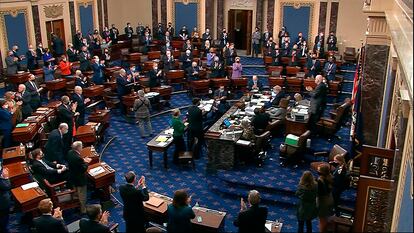Six keys to understanding the new US stimulus package
The Senate has approved the Covid-19 relief bill aimed at rescuing the economy from fallout of the coronavirus pandemic, but measures such as a rise in the minimum wage were rejected


On Saturday, the United States Senate approved the third major coronavirus stimulus package after a long day of debate. Aimed at saving the country’s economy from the ravages of the pandemic, the Covid-19 relief bill is the first major legislative victory of President Joe Biden. The $1.9 trillion (€1.59 trillion) package was passed with 50 Democratic votes in favor, and 49 Republican votes against. It includes direct stimulus check payments to citizens and funds to speed up the Covid-19 vaccination program, among another long list of measures.
On its passage through Congress, it has been subject to a series of changes, with some amendments demanded by the Republicans being rejected by the Democrats, and others accepted. Here is a summary of what’s been included and what fell by the wayside.
The stimulus check recipients
In its first version, the House of Representatives approved direct stimulus checks of $1,400 (€1,175, more than double the $600 approved as part of the previous congressional aid program). These were to be sent to people earning under $75,000 a year (€62,900) or married couples who earned up to $150,000 (€126,300). The value of the checks would gradually fall until reaching zero for individuals earning about $100,000 a year (€84,000) and couples who earn between $150,000 and $200,000 (€168,000).
However, the Senate reduced the earnings ceilings for individuals to $80,000 a year (€67,300), and for couples to $160,000 (€134,000). In any case, the majority of Americans will benefit, given that the average annual family income is $68,703 (€57,655). The reduction leaves out around eight million households who, in the draft from the House of Representatives, did have the right to the checks, according to an analysis by the Center for Fiscal Policy. Adults with special needs and college students will be able to receive the checks, unlike in the first round.
Unemployment payments
Jobless benefits of $300 a week (€250) that were approved in the last rescue package will run out on March 14. The House of Representatives had agreed that the payment would be $400 (€336) this time around, but the Senate has once again reduced it to $300. Another modification by the senators is the last payment of the benefits: the scheme will be extended from August 29 – the date agreed by congressmen – to September 6, 2021. Democratic senators wanted it to be extended to October. There will also be tax relief for those who earn less than $150,000 a year. This extra help will be added to the benefits that the states regularly grant to the unemployed.
A rise in the minimum wage
The Senate eliminated lawmakers’ proposal to gradually increase the federal minimum wage from $7.25 (€6.11) to $15 per hour (€12.63) for 2025. Seven Democrats and one independent voted together with the Republican bloc, representing a major defeat for the progressive wing of the Democratic Party, led by Senator Bernie Sanders. The exclusion of this measure was no surprise, given that Elizabeth MacDonough – the Parliamentarian of the United States Senate, i.e the official advisor on the interpretation of Standing Rules of the United States Senate and parliamentary procedure – had determined that it violated the rules of the budget reconciliation process.
Help for rural hospitals
The Senate included a package of extra aid of $8.5 billion (€7.13 billion) in the aid fund for certain rural suppliers and hospitals, well below the $35 billion (€29 billion) requested by the interested parties. The draft law does not define who these possible rural suppliers are, but it is assumed that the US Department of Health and Human Services (HHS) will apply the same definition that it used to implement specific funds for rural suppliers last year.
Healthcare plans for the unemployed
Workers who lose their jobs in the United States can stay on their company’s health plan for 18 months under the Consolidated Omnibus Budget Reconciliation Act (COBRA), but will have to pay the full monthly premium. The House of Representatives approved a temporary subsidy of 85% of the insurance premiums. The Senate raised the subsidy to 100% to guarantee that fired workers can stay on their employer health plans at no cost until the end of September.
As the provisions contained in the last two sections were not in the draft law approved by the House of Representatives, the Senate will have to send them back to the lower house so that lawmakers can vote on them before President Biden signs the package into law.
What was not changed
Biden’s plan includes $350 billion (€294 billion) in emergency funds for state, local and territorial governments destined for frontline workers. Schools will receive $130 billion (€109 billion) for their safe reopening plan, including the purchase of personal protective equipment, modernization of ventilation systems and staff for infirmaries. More than a million small businesses will be able to count on a fund with $15 billion (€13 billion) in subsidies. The aid package also includes a national program of $20 billion (€16.8 billion) to set up community vaccination centers in the country and another $50 billion (€42 billion) to ramp up testing, allowing schools and local governments to implement routine testing, among other measures aimed at palliating the effects of the pandemic.
English version by Simon Hunter.
Tu suscripción se está usando en otro dispositivo
¿Quieres añadir otro usuario a tu suscripción?
Si continúas leyendo en este dispositivo, no se podrá leer en el otro.
FlechaTu suscripción se está usando en otro dispositivo y solo puedes acceder a EL PAÍS desde un dispositivo a la vez.
Si quieres compartir tu cuenta, cambia tu suscripción a la modalidad Premium, así podrás añadir otro usuario. Cada uno accederá con su propia cuenta de email, lo que os permitirá personalizar vuestra experiencia en EL PAÍS.
¿Tienes una suscripción de empresa? Accede aquí para contratar más cuentas.
En el caso de no saber quién está usando tu cuenta, te recomendamos cambiar tu contraseña aquí.
Si decides continuar compartiendo tu cuenta, este mensaje se mostrará en tu dispositivo y en el de la otra persona que está usando tu cuenta de forma indefinida, afectando a tu experiencia de lectura. Puedes consultar aquí los términos y condiciones de la suscripción digital.
More information
Archived In
Últimas noticias
Venezuelan oil, the ultimate prize coveted by the United States
Trump presses a new button in his strategy against Maduro: Economic strangulation through oil
Trump’s impact on International Migrants Day: ‘It has been one of the most difficult years, the cruelest’
Trump delivers address to the nation to exaggerate his achievements and blame Biden for the state of the economy
Most viewed
- Christian Louboutin: ‘Young people don’t want to be like their parents. And if their parents wear sneakers, they’re going to look for something else’
- ‘El Limones’ and the growing union disguise of Mexican organized crime
- The low-cost creative revolution: How technology is making art accessible to everyone
- ‘We are dying’: Cuba sinks into a health crisis amid medicine shortages and misdiagnosis
- Liset Menéndez de la Prida, neuroscientist: ‘It’s not normal to constantly seek pleasure; it’s important to be bored, to be calm’










































